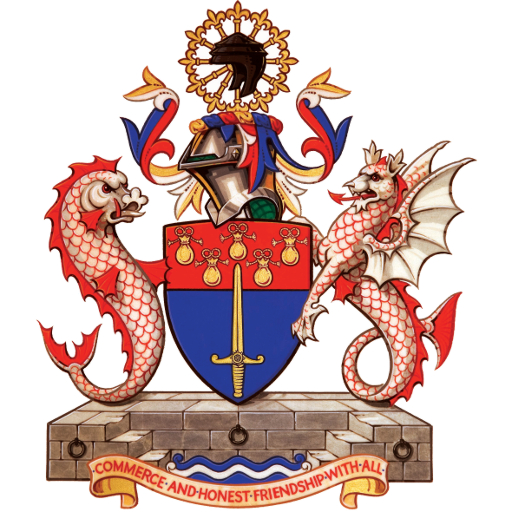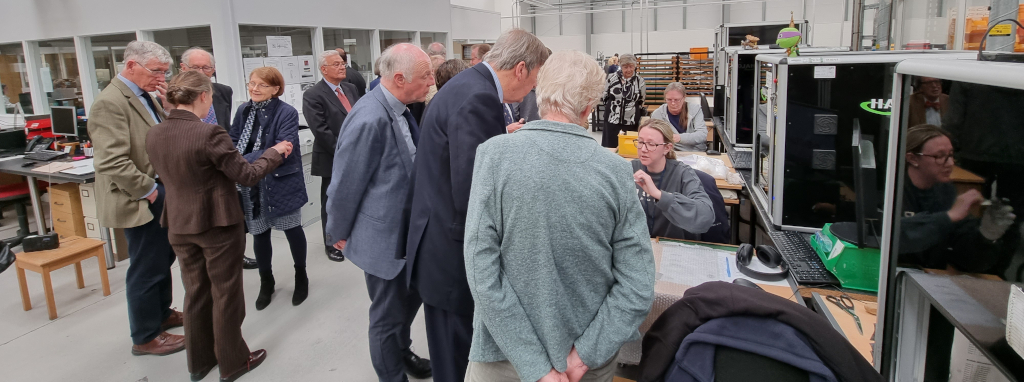4 May: World Traders Welcomed to York
This year the Master World Trader’s annual outreach to foreign parts began with arrival in York as a base for expeditions into even remoter parts of God’s own county. We were received with genuine warmth by our northern cousins, the Company of the Merchant Adventurers of the City of York at their magnificent and ancient Hall.
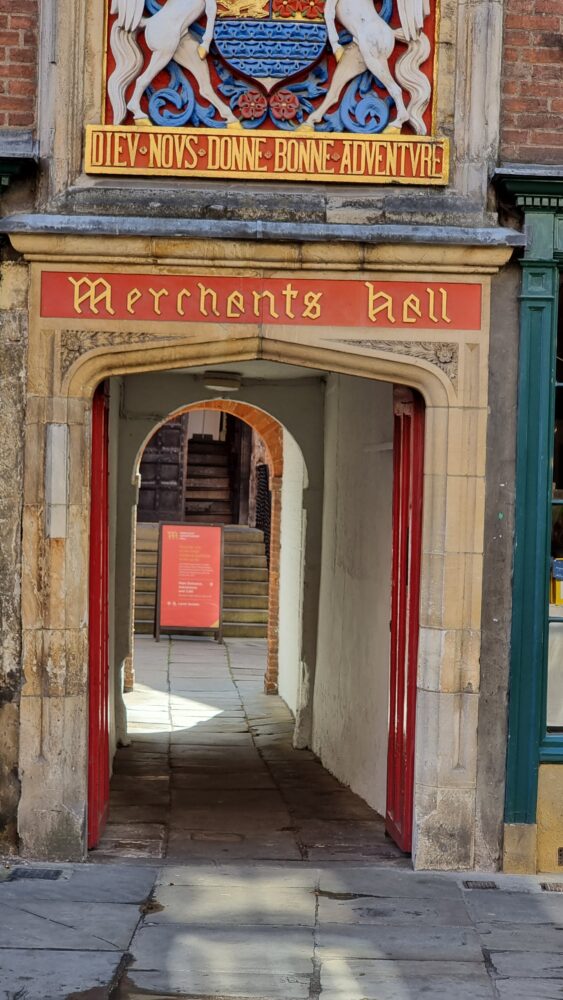
In his welcoming address the distinguished archaeologist Dr Peter Addyman CBE immediately drew attention to the connections that can be made between the Cities of York and of London including the fact that our adopted Roman historian Tacitus wrote of the trading activities of both cities. He gave us an impressive summary of 2,000 years of history of York in about fifteen minutes. Not to be overawed by comparisons with Roman London, he reminded us that York had been a significant trading centre since the 9th Legion founded the garrison of Eboracum in around 71 AD. The remains are now twenty feet below present ground level. From here, Emperor Hadrian ordered the building of the wall that bears his name. Two hundred and fifty years later, the 6th Legion proclaimed Constantine emperor in York and changed history, presaging the growth of the eastern Roman Empire and Christianity.
Another three hundred years on and the missionary, Paulinus, sent by Pope Gregory, founded the monastery church of St Peter, that over the next half century became York Minster. In the meantime, York had become a centre of learning. The Anglo-Saxon scholar, Alcuin, was headhunted to advise Charlemagne who needed assistance creating the Holy Roman Empire (as he could neither read nor write).
By now we were getting the message that many important historical events had their origins in York but Dr Addyman was just getting into his stride and went on to describe the impact of the Viking era. He had been directly involved in excavating Viking remains prior to the creation of the hugely successful Jorvik Centre tourist attraction. More evidence of trading was revealed in the process of excavation, linking York with centres throughout western Europe and beyond.
Then it was the turn of Brigadier Jim Richardson MBE, Clerk to the Merchant Adventurers, to give us a tour of the Hall and a history of the building and the company. This began in 1357 when a group of prominent local citizens created the Guild of Our Lord Jesus and the Blessed Virgin Mary to provide accommodation for thirteen ‘poor and feeble’ people. The original chapel dates from this time and the almshouse residents lived in the undercroft where each had their own niche in which to store their meagre worldly possessions. The Guild was changed in a royal charter granted by Henry VI in 1430 into the Mistry of Mercers. Then, in 1581, it was changed again to The Company of Merchant Adventurers of York in 1581 in the reign of Elizabeth I.
The Merchant Adventurers are justifiably proud of their unbroken stewardship of the traditions of the Company and of the Hall. They have records that go back to the purchasing of materials for the original building. We were privileged to have dined sumptuously in the medieval hall on Goat’s Cheese, Roast Guinea Fowl and Poached Pear. We were joined by the Revd Chris Cullwick, Lord Mayor of York, and the Governor of the Merchant Adventurers, Delma Tomlin MBE.
In her speech of thanks, it was left to World Traders Master Mary Hardy to congratulate Governor Tomlin on becoming the first woman to be elected to the office in 665 years. It was mentioned that in its comparatively short life, the World Traders has had eight female Masters, five in the last ten years.
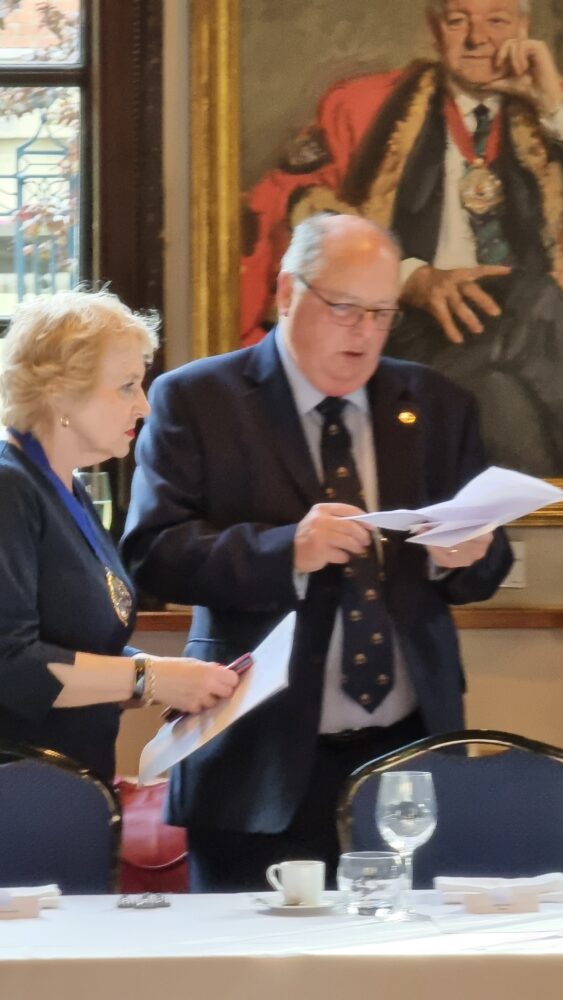
So, well-primed to hear of all the good things that have come out of Yorkshire, the party was ready to move on to the steel towns of Sheffield and Rotherham where they would no doubt learn of the impact of Henry Bessemer’s inventions and then to Whitby where it would not be possible to avoid being regaled with the exploits of Captain James Cook and how he influenced world trade, all while tucking into fish and chips.
Simon Maddocks
5 May: Industry and Business
On Thursday, we immersed ourselves in a day trip to Rotherham and Sheffield – the steel powerhouse of Yorkshire – to uncover some of the stories and metal crafts the region has to offer.
Galivanting over the golden rapeseed fields, we arrived mid-morning at one of the biggest designers and manufacturers of mechanical seals and seals support systems – AESSEAL in Rotherham.
We were made very welcome by an enthusiastic and dedicated team who kindly gave us a fascinating tour of their state-of-the-art facility. With health and safety a number one priority, we were thoroughly briefed by the team so that we could enjoy a safe tour around the manufacturing floor.
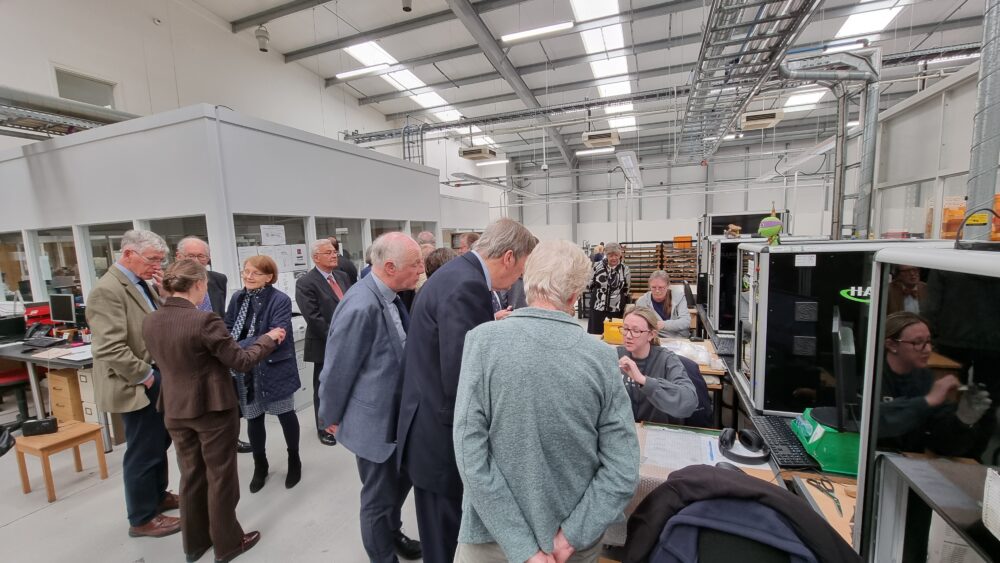
The team explained to us from ‘A’ to ‘Z’ how mechanical seals are designed, manufactured, tested, quality assured, packaged and delivered. More than 200 seals are inspected manually every single day by a team of experts with more than 15 years’ experience. A forward-looking company, AESSEAL is constantly looking for ways to innovate and increase efficiency; the company has recently acquired a robotic arm able to operate two of its laser machines.
Established in 1979, AESSEAL has offices in 104 countries and over 1800 people across the group. The company’s manufacturing plants operate 24/7, 363 days per year, guaranteeing 48 hour delivery worldwide on their standard products. Its turnover reached £20m for the first time in March 2022.
AESSEAL’s recipe for success? Investment in its most important asset, its people – and its most important stakeholder – the planet. The leadership team is dedicated to attracting young talent into engineering, offering apprenticeship schemes for college students in Mechanical Engineering; currently there are 51 apprentices. What was more fascinating, was the company’s commitment to protect the environment. Its seal solutions and support systems have been proven to reduce energy and water consumption and industrial CO2 emissions. The company is on target to achieve global net zero greenhouse gas emissions across all its locations worldwide by 2029. In light of its accomplishment, AESSEAL has launched a global campaign – Better World – to drive collective action to mitigate climate change across all industries. No wonder they have received the Queen’s Award for Enterprise in the sustainable development category.
After such an inspirational visit, we made our way to the Cutlers’ Hall in Sheffield; where friendships were forged by our members over a delicious meal, learning the secrets of one of the finest livery halls in the north of England. The Cutlers’ Company has sought to maintain the standards and quality of Sheffield manufactured cutlery and steel products since 1624. The hall has an impressive archive covering almost four hundred years of activities. Much more time was needed to uncover the rich history and fascinating stories of Cutlers’ Hall, perhaps a visit for another day.
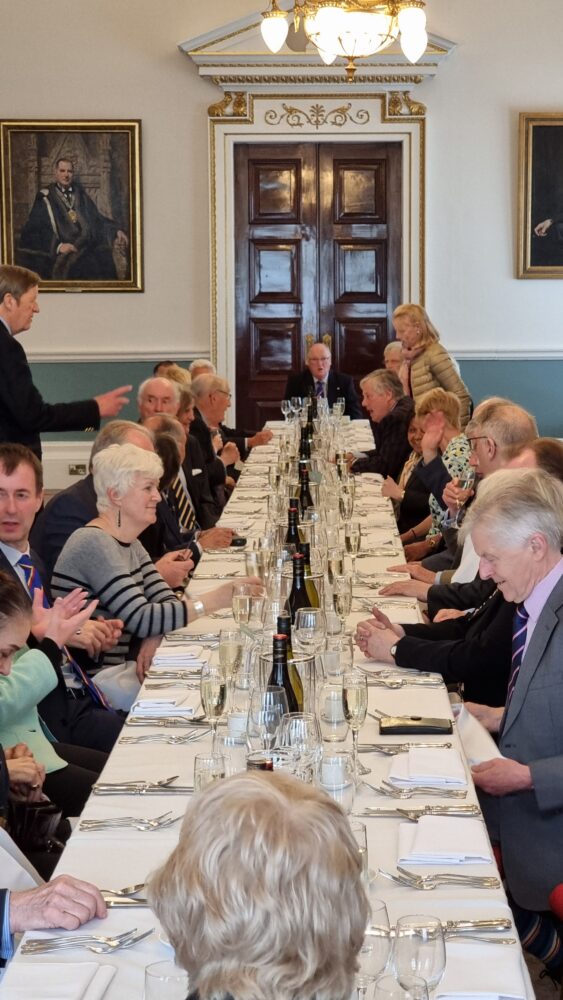
Hungry for more, we proceeded to the Sheffield Assay Office where more than 10,000 items (ranging from medical devices to jewellery) made from gold, silver, platinum and/or palladium are tested and assessed every single day. The Sheffield Assay Office was one of the driving forces in bringing about legislation for the marking of mixed metals, in order to offer consumers more accurate descriptions of the items they are purchasing. Some of our World Traders were brave enough to assay their wedding bands and rest assured no domestic challenges were encountered!
The day concluded with a journey back to the Middleton’s Hotel in York, where World Traders enjoyed a free evening exploring the historic town.
Oana Lazar
6 May: Visit to Whitby
Day Three of the World Traders’ visit to Yorkshire saw a rather excited and expectant group muster early for the coach ride to Pickering, on the first leg of a journey that would take us to the ‘Yorkshire riviera’ port of Whitby.
Pickering was a step back in time and pace as, amidst the nostalgic squeals of delight, we boarded a steam train for the leisurely but utterly glorious trip across the North Yorkshire Moors towards the coast. The two-hour trip passed all to quickly as we revelled in being in a slightly rickety train carriage with the air permeated by the faint whiff of coal smoke and steam.
Our train ride over, the delights of Whitby awaited. With our Yorkshire Master leading, our first stop was for the almost obligatory fish and chip lunch. Following this, our party broke into smaller groups for a chance to look around the town. For some, a boat trip around the harbour was a must. Other energetic souls tackled the 199 steps to see the famous Abbey, a former Benedictine monastery which formed part of the inspiration for Bram Stoker’s Dracula novel. Other sensible souls took a more leisurely approach and wandered the interesting streets.
As the day drew to a close, the various groups returned to the coach, many with ice cream in hand, to top off a wonderfully relaxing day. Our return to York was quiet and peaceful as for many, the combination of sea air, good food and a vigorous walk had a very soporific effect.
Nick Chatwin
6 May: Dinner at Merchant Taylors’ Hall
The beautiful dining room of the Merchant Taylors’ Hall was the perfect backdrop for the final dinner of our Yorkshire trip. This charming location was not the only source of the excitement during the evening, as a sudden scarcity of personnel in the kitchens required the drafting in of five chefs from among the ranks of the World Traders. Luckily, these five volunteers were chosen with care and all of them did a great job at carving the roast beef.
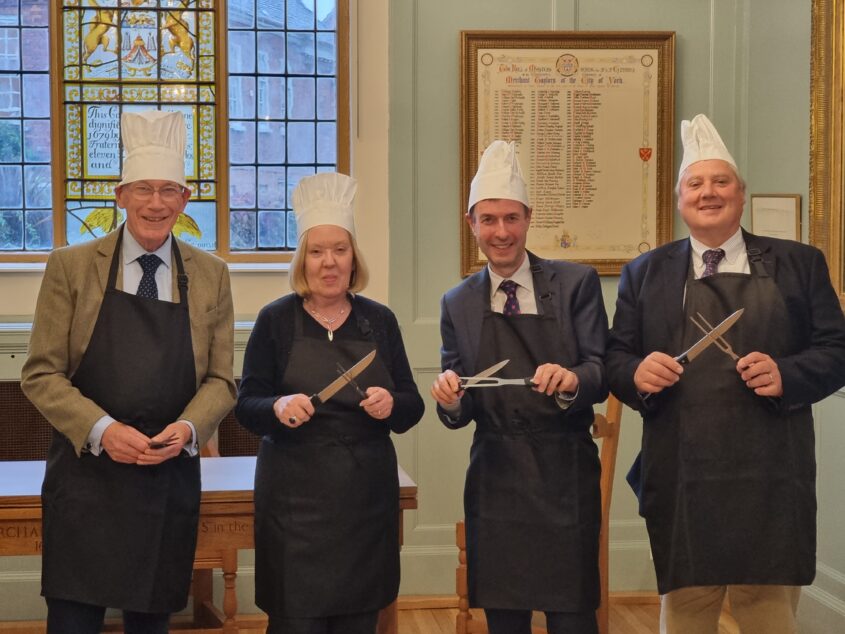
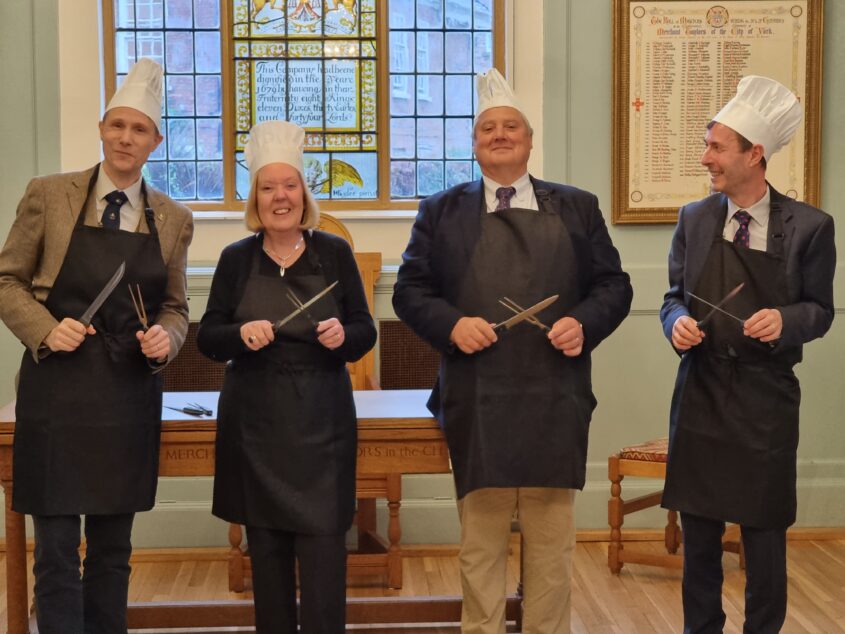
A rebellious speech from Senior Warden Michael Shapiro followed the meal, and a gift crate of diet coke was presented to the Master to show everyone’s gratitude for arranging such a lovely trip. The evening was not quite over yet, as more surprises were awaiting us. A poem explaining the origins of Yorkshire pudding was recited by the Master and a quiz soon followed. The World Traders proved that they had paid attention during the previous three days, as their knowledge of Yorkshire was put to the test. Two tables shared the first prize of chocolate bars (not gold bars from the Sheffield Assay Office, unfortunately!) and this concluded our last evening together in York.
Alberto Xodo
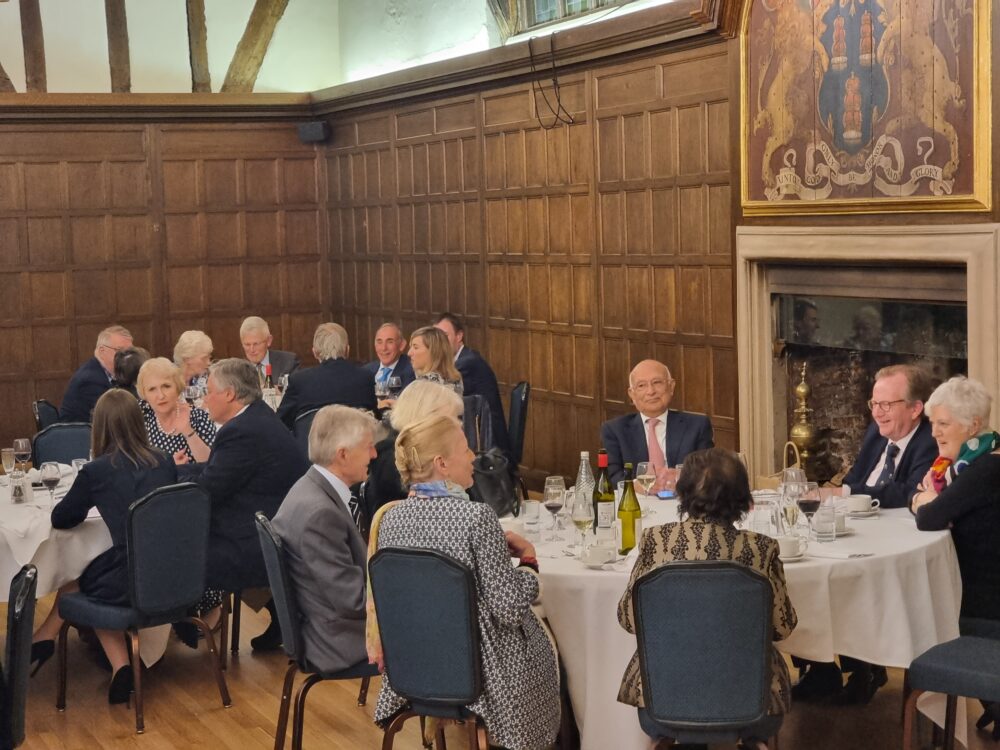
7 May: Visit to the Jorvik Viking Centre in York
The final event of the very successful, informative and enjoyable Master’s visit to Yorkshire was a visit to the Jorvik Viking Centre in the centre of York. The museum is on the site where the remains of a 10th century Viking settlement were discovered during excavations in Coppergate during 1976. Living quarters discovered in 1976 can be viewed under a glass floor. Thirty-three World Traders and partners spent a fascinating morning learning about Viking life from a number of presentations by presenters in period costume, displays and a ride through an animatronic 10th century Viking village.
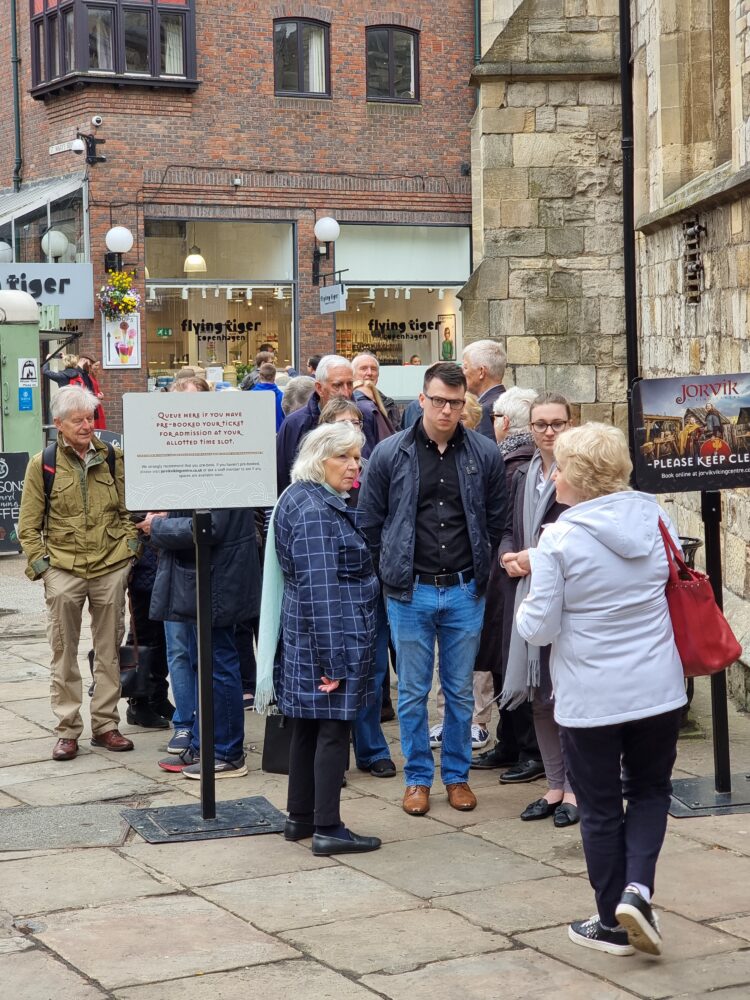
Among the many artifacts on display is the largest human coprolite ever discovered (if you don’t know what a coprolite is – look it up). See the picture below.

Other artifacts on display ranged from leather shoes to clothing, cooking utensils to swords and a collection of over 200 items of silver jewellery dating from around 900 AD, when the city of Jorvik (now called York) was one of the most important cities in England.
As the tour of this Viking city was the last item on the Master’s visit to York it concluded with goodbyes to friends old and new, only for many of us to meet up later in the day in York Minster, the hotel, pub or railway station.



